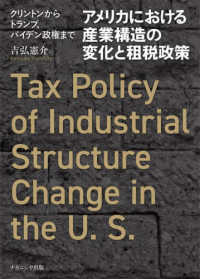- ホーム
- > 洋書
- > 英文書
- > Politics / International Relations
Full Description
Though it is rarely explicitly articulated, many believe that there is no "public" in the Middle East. Scholarship on the Middle East and North Africa almost always engages with politics-a prominent focus of this region-yet the assumed absence of public spaces and fora has led many to think that debate, consensus, and concerted social action are antithetical to the cultural, religious, and national heritage of the region. It is a mistake to exclude the public dimension from the study of processes in this region. Recent studies have demonstrated not only the critical importance of the public in everyday practices of the MENA region, but they have also shown how the term and notion of the public sphere can be used productively to advance understandings of collective life. The first section of this volume offers alternative conceptions of the public sphere through rich and innovative theoretical analysis. Philosophical investigations focus on the role of collective action, the relationship between nationalism and democracy, and the notions of the public employed by socioreligious movements.
The second section addresses a wide range of counter-hegemonic discourses and practices that enable the public sphere, such as memoirs, testimonies, strategies of surveillance, the Tehran bazaar, and the movements of migratory workers. The third section provides empirical accounts of the way in which mutual communication through technology has vitally expanded the notion of the public in the MENA region. In conclusion, conflict and resistance are shown to be generative forces in public discourse and debate and in the production of national publics.







